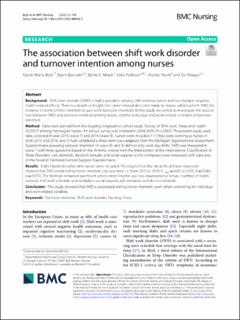| dc.description.abstract | Background: Shift work disorder (SWD) is highly prevalent among shift-working nurses and has multiple negative health-related effects. There is a dearth of insight into career-related decisions made by nurses suffering from SWD, for instance in terms of their intention to quit work (turnover intention). In this study, we aimed to investigate the association between SWD and turnover intention among nurses, and the individual and work-related correlates of turnover intention.
Method: Data were derived from the ongoing longitudinal cohort study “SUrvey of Shift work, Sleep and Health (SUSSH)” among Norwegian nurses. An annual survey was initiated in 2008/2009 (N = 2965). The present study used data collected in year 2015 (wave 7) and 2016 (wave 8). Nurses were included if: 1) they were working as nurses in both 2015 and 2016, and 2) had completed a three-item scale adapted from the Michigan Organizational Assessment Questionnaire assessing turnover intention (in wave 8), and 3) did not only work day-shifts. SWD was measured in wave 7 with three questions based on the minimal criteria from the third edition of the International Classification of Sleep Disorders. Job demands, decision latitude, and social support at the workplace were measured with subscales of the Swedish Demand-Control-Support Questionnaire.
Results: Eight Hundred eighty-nine nurses were included. The results from the hierarchical linear regression showed that SWD predicted turnover intention one year later, i.e. from 2015 to 2016 (F1,835 = 6.00, p < 0.05; β = 0.084, p = 0.015). The findings remained significant when controlling for age, sex, organizational tenure, number of nights worked, shift work schedule and workplace social support, job demands and decision latitude.
Conclusion: This study showed that SWD is associated with turnover intention, even when controlling for individual and work-related variables. | en_US |

